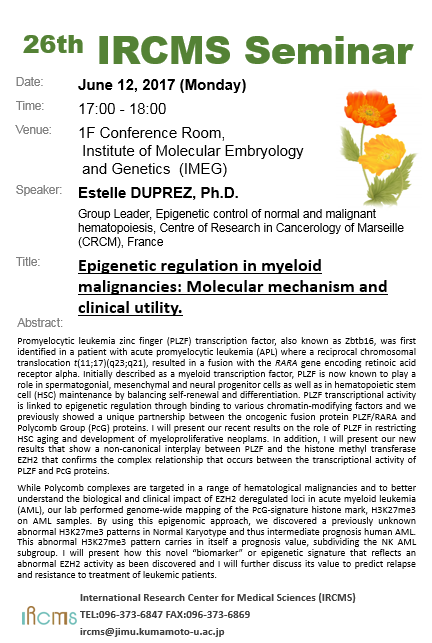- HOME
- IRCMS Seminars
- 26th IRCMS Seminar
IRCMS Seminars
26th IRCMS Seminar
June 12 2017
We had a large number of participants come to the 26th IRCMS Seminar held on June 12, for which we would like to express our gratitude.
Date: June 12, 2017 (Fri) Time: 17:00 - 18:00
Venue: 1F Conference Room, Institute of Molecular Embryology and Genetics (IMEG)
Speaker: Estelle DUPREZ, Ph.D.
Group Leader, Epigenetic control of normal and malignant hematopoiesis, Centre of Research in Cancerology of Marseille (CRCM), France
"Epigenetic regulation in myeloid malignancies: Molecular mechanism and clinical utility."
Promyelocytic leukemia zinc finger (PLZF) transcription factor, also known as Zbtb16, was first identified in a patient with acute promyelocytic leukemia (APL) where a reciprocal chromosomal translocation t(11;17)(q23;q21), resulted in a fusion with the RARA gene encoding retinoic acid receptor alpha. Initially described as a myeloid transcription factor, PLZF is now known to play a role in spermatogonial, mesenchymal and neural progenitor cells as well as in hematopoietic stem cell (HSC) maintenance by balancing self-renewal and differentiation. PLZF transcriptional activity is linked to epigenetic regulation through binding to various chromatin-modifying factors and we previously showed a unique partnership between the oncogenic fusion protein PLZF/RARA and Polycomb Group (PcG) proteins. I will present our recent results on the role of PLZF in restricting HSC aging and development of myeloproliferative neoplams. In addition, I will present our new results that show a non-canonical interplay between PLZF and the histone methyl transferase EZH2 that confirms the complex relationship that occurs between the transcriptional activity of PLZF and PcG proteins.
While Polycomb complexes are targeted in a range of hematological malignancies and to better understand the biological and clinical impact of EZH2 deregulated loci in acute myeloid leukemia (AML), our lab performed genome-wide mapping of the PcG-signature histone mark, H3K27me3 on AML samples. By using this epigenomic approach, we discovered a previously unknown abnormal H3K27me3 patterns in Normal Karyotype and thus intermediate prognosis human AML. This abnormal H3K27me3 pattern carries in itself a prognosis value, subdividing the NK AML subgroup. I will present how this novel "biomarker" or epigenetic signature that reflects an abnormal EZH2 activity as been discovered and I will further discuss its value to predict relapse and resistance to treatment of leukemic patients.

